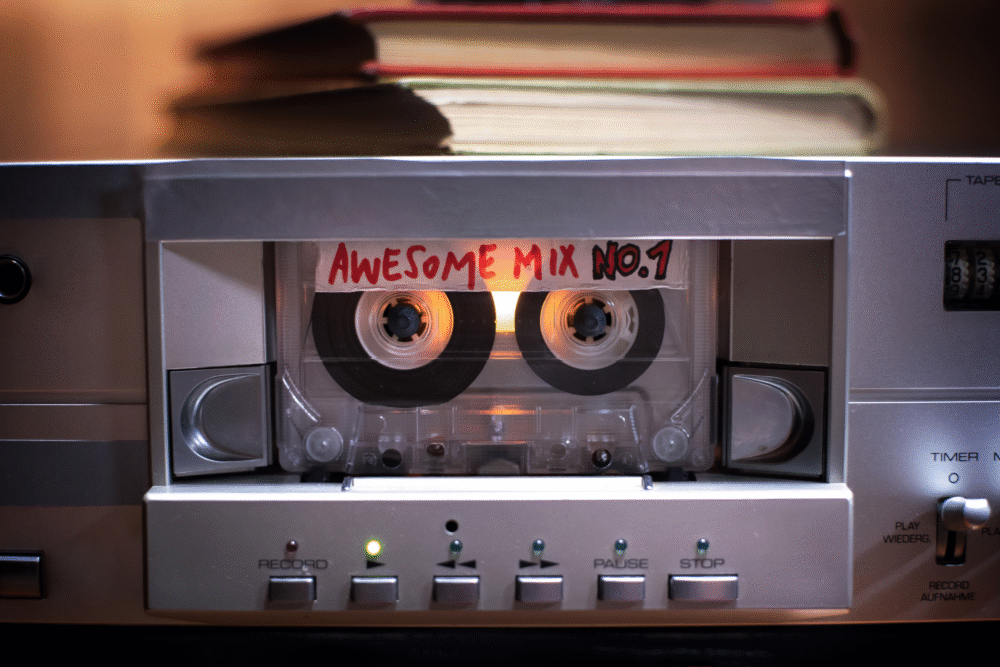Gen Z’s yearning for tangible experiences is leading to a retro revival.

In a world where digital dominates every facet of life, Gen Z is actively seeking out analog experiences to ground themselves in something real and tactile. This generation, fluent in the language of the internet, is turning to the past not out of a desire to turn back time but to find a sense of authenticity and presence that feels lost in the endless scroll of social media. These habits are a form of conscious rebellion against the curated and often overwhelming digital landscape.
Their fascination with retro activities is a quest for intentionality and genuine connection. These habits, once considered old-fashioned, provide a much-needed break from the constant performance of online life. They offer a space for creativity, reflection, and human interaction that is unfiltered and unscripted. It’s about finding satisfaction in the deliberate and the imperfect, a stark contrast to the instant and flawless nature of modern technology.
1. The art of letter writing has found a new, personal purpose.

In an age of instant messages and fleeting texts, the act of writing and sending a physical letter has become a deeply meaningful ritual. It’s a slow, deliberate process that forces you to carefully craft your thoughts and emotions, making each word feel more significant. This habit offers a unique kind of intimacy and patience, a tangible connection to someone that transcends the immediacy of digital communication. The letter itself becomes a keepsake, a physical object that can be held and cherished for years to come.
This resurgence is driven by a desire for a more personal and heartfelt form of connection. A handwritten letter is an artifact of time and effort, a testament to the relationship it represents. It’s a deliberate rejection of the fast-paced, often impersonal nature of online conversation, offering a much-needed return to a slower, more intentional way of communicating. The simple joy of receiving a letter in the mail provides a moment of genuine excitement that is rarely found in an email inbox.
2. Physical photo albums are being made to preserve memories.

While countless photos are stored on phones and in cloud services, Gen Z is rediscovering the joy of curating physical photo albums. Instead of being lost in a digital abyss, carefully selected memories are printed, placed in albums, and organized with intention. This practice transforms a casual snapshot into a significant moment, a piece of a larger personal narrative. The act of flipping through the pages of an album is a tangible journey back in time, allowing you to relive experiences in a way that scrolling through a phone screen cannot replicate.
This habit is a response to the fleeting nature of digital photography, which often feels disposable. Creating a physical album is an act of preservation, a way to anchor memories in the real world. It makes a powerful statement about which moments truly matter, elevating them above the millions of other photos taken and forgotten. Sharing an album with friends or family becomes a communal experience, a time to tell stories and connect over shared history, offering a sense of permanence and substance.
3. Reading physical books is a way to escape digital distractions.

In a world of endless screens and notifications, reading a physical book has become a form of intentional escape. The weight of the book in your hands, the rustling of the pages, and the smell of the paper create an immersive experience that digital devices simply can’t replicate. This habit allows for a deep, focused concentration on a single narrative without the constant pull of social media, emails, or texts. It’s a dedicated period of time for imaginative transport, a quiet rebellion against the multitasking demands of modern life.
This return to physical books is about reclaiming attention and finding satisfaction in a slow, uninterrupted activity. Unlike an e-reader or a phone, a physical book has a clear beginning and end, offering a sense of accomplishment with every finished chapter and turned page. The book itself becomes a trophy of a journey taken, a tangible reminder of a story experienced. This practice offers a grounding and meditative experience, a way to intentionally disconnect from the digital world and reconnect with a story.
4. Thrift store treasure hunting has become a cherished weekend ritual.

Forget fast fashion and online shopping; Gen Z is flocking to thrift stores in search of unique, pre-loved items with a story. The process of sifting through racks and shelves is a mindful and engaging activity, a refreshing alternative to the instant gratification of online retail. Each find feels like a victory, a one-of-a-kind piece that reflects personal style and creativity. This habit is about more than just saving money; it’s about a connection to the past and a rejection of mass-produced consumerism, giving old items a second chance at life.
Thrifting offers an opportunity for self-expression and sustainability. The clothes and items you find are imbued with history, carrying a sense of character that new products lack. This ritual provides a tangible, real-world experience, a break from the monotony of algorithms dictating what you see and buy. It’s a low-stakes adventure that encourages spontaneity and a more thoughtful approach to what you bring into your life, making it a conscious and fulfilling habit.
5. Hosting in-person dinner parties is making a real comeback.

In a culture of quick takeout and virtual hangouts, the traditional dinner party is being revived as a cherished social event. The effort of cooking a meal, setting the table, and gathering friends around a shared table creates a space for genuine, face-to-face connection. This habit is a conscious rejection of the casual and often impersonal nature of online interaction, offering a structured environment for deep conversation and shared experiences. The whole ritual, from preparing the food to cleaning up afterwards, is a communal effort that strengthens bonds.
This practice is driven by a longing for authentic community and the simple pleasure of human connection. A dinner party is an invitation to be present, to put away phones and engage in meaningful dialogue. It’s a way to slow down and savor both the food and the company. The intentionality of a shared meal fosters a sense of belonging and creates lasting memories that transcend a digital chat, offering a powerful sense of togetherness that feels both comforting and real.
6. Journaling by hand is a method for thoughtful self-reflection.

With the proliferation of digital calendars and notes apps, the analog habit of journaling by hand is experiencing a revival as a powerful tool for self-reflection. The physical act of putting pen to paper forces a slower, more deliberate thought process than typing. This habit offers a private, unfiltered space to process emotions, track goals, and record memories without the distraction of a screen. The notebook itself becomes a tangible record of personal growth, a physical archive of thoughts and feelings.
This return to handwritten journaling is a response to the constant pressure of digital performance and the feeling of being perpetually “on.” It’s a way to disconnect from the public-facing aspects of life and engage in a truly private act of introspection. The imperfect handwriting, the ink stains, and the filled pages are all part of the process, making the journal an authentic and personal artifact. This practice offers a calming, meditative outlet, a simple and powerful way to connect with yourself in a deep and meaningful way.
7. Learning to knit or crochet is a new creative outlet.

In a world where most consumer products are manufactured by machines, Gen Z is turning to traditional crafts like knitting and crocheting to create something tangible with their own hands. This habit provides a meditative, repetitive action that is both calming and productive. It offers a sense of accomplishment with every stitch and a deep satisfaction in turning a simple ball of yarn into a wearable piece of art. This practice is a hands-on rejection of the passive consumption that defines so much of modern life.
This hobby is driven by a desire for a creative outlet that is both practical and slow. Unlike digital creative pursuits, knitting and crocheting produce a physical object that can be used or gifted, imbuing it with a sense of purpose. It’s a way to reclaim time and attention, focusing on a single, deliberate task rather than jumping between different screens and apps. The act of creation itself offers a powerful antidote to the fast-paced, ephemeral nature of the digital world.
8. Making a physical mixtape is a deeply personal form of expression.

Long before streaming playlists, the mixtape was the ultimate form of musical expression and connection. Today, Gen Z is reviving the art of crafting physical mixtapes on cassette tapes or CDs. This habit involves carefully selecting songs, sequencing them in a meaningful order, and often designing personalized artwork. The entire process is a thoughtful and creative act, a tangible way to convey feelings and share a story through music. The mixtape becomes a physical gift, a symbol of time and effort.
This revival is about more than just the music; it’s about the intentionality behind the curation. Unlike a shared digital playlist, a physical mixtape feels more permanent and intimate. It’s a unique and personal artifact that represents a specific moment in time and a relationship with another person. This practice offers a powerful contrast to the algorithmic nature of modern music discovery, putting the power of curation and personal storytelling back into the hands of the creator.
9. Playing board games is a way to have fun without a screen.

In a landscape dominated by video games and online multiplayer, the simple pleasure of a board game night is making a strong comeback. This habit brings people together around a physical table for a shared experience that is both social and competitive. Board games require players to interact face-to-face, read non-verbal cues, and engage in real-time conversation. It’s a deliberate rejection of digital isolation, offering a communal activity that is fun, challenging, and deeply human.
This trend is a response to the need for authentic, screen-free entertainment. Playing a board game provides a structured social environment where people can connect without the distractions of their phones. The physical presence of the board, the pieces, and the cards offers a tactile experience that is both engaging and grounding. This activity fosters a sense of togetherness and friendly competition, creating a space for shared laughter and memorable moments that feel truly present and real.
10. Cooking elaborate meals at home is a new form of creativity.

In a society of convenience and instant gratification, Gen Z is finding deep satisfaction in the slow and deliberate process of cooking elaborate meals from scratch. This habit is a form of mindful meditation, a creative outlet that engages all the senses. The process of chopping, seasoning, and waiting for a meal to come together is a grounding and rewarding experience. It offers a sense of accomplishment and a physical reward that is both delicious and nourishing. Cooking is an escape from the fast-paced nature of modern life.
This revival of home cooking is about a desire for authenticity and a connection to what we consume. It is a way to be intentional about the food we eat and to appreciate the effort that goes into making it. The shared experience of cooking and eating a meal together with loved ones fosters a sense of community and connection that is hard to find elsewhere. This habit is a powerful way to express care, creativity, and presence in a deeply tangible and satisfying way.
